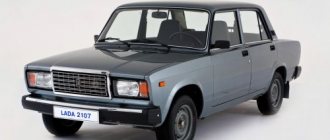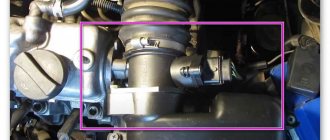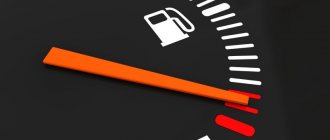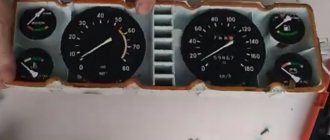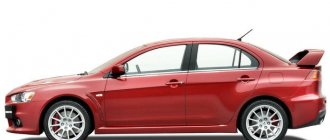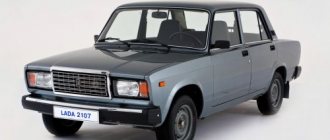VAZ 2107 fuel consumption per 100 km carburetor
To talk about whether a car consumes a lot of gasoline, you need to know what the consumption should actually be.
Depending on the engine installed on the car, the consumption may be as follows (for more details on the consumption of carburetor cars, see our fuel consumption table for carburetor cars):
| Engine | Consumption per 100 km |
| VAZ 2102, 2103 (1.5, Carburetor) | Average 10.5 / city 11.5 / highway 7.2 |
| 2106 (1.57 engine, carburetor, four-speed gearbox) | Average 9.5 / city 10.5 / highway 8.5 |
| 2106 (1.45 engine, carburetor, four-speed gearbox) | Average 9.9 / city 10.8 / highway 9.0 |
| 2107 (1.6, carburetor) | Average 8.9 / city 10.2 / highway 7.5 |
| 2107 (1.5, carburetor) | Average 8.3 / city 9.6 / highway 7 |
The difference is obvious. However, the power of the first engine is 72 hp. , and the second one is 80. That’s why it consumes so much gasoline. However, in the case when there is an increase in consumption above the nominal, it is worth talking about too much fuel consumption.
VAZ 2103
Another of the pioneer models, which first rolled off the factory lines of the Volzhsky Automobile Plant in 1972. The VAZ 2103 sold well in the countries of the socialist camp, where it was delivered under the name Lada 1500. Production of the model was discontinued in 1984, replacing it with the more advanced “seven”. The Troika was equipped with one of three engines (1.2, 1.3 and 1.5 liters in volume and power of 64, 69 and 75 hp, respectively). All power units were accompanied by a four-speed “mechanics”, and fuel was supplied using a carburetor.
| Engine | Consumption (city) | Consumption (highway) | Flow (mixed) | Type of fuel |
| 1.2 MT 64 hp | 8.8 | 8.2 | 8.6 | Petrol |
| 1.3 MT 69 hp | 11.4 | 8.2 | 10.0 | |
| 1.5 MT 75 hp | 11.5 | 8.3 | 9.4 |
Engine power system
Conventionally, the power supply system can be divided into two elements:
- Air supply;
- Fuel supply.
Let's consider the first option. If your car consumes too much gasoline, the problem may lie in a dirty air filter. All drivers should know that without oxygen, fuel combustion is impossible. Fuel consumption should be carried out in a ratio of 1 kg of fuel to 15 kg of air. This parameter is not always present, but should have approximate values.
If the air filter is dirty, it will turn out that fuel combustion will be poor, which means the engine efficiency will decrease, which is the reason why the VAZ 2107 carburetor has high fuel consumption, but there are other reasons, which lie in the operation of the carburetor itself .
If it is not set correctly, the Lada will have an air/fuel mixture that is too rich or too lean. In both cases, it consumes a lot of fuel and noticeably loses power. To get rid of the problem, you need to configure the system correctly. If the VAZ 2107, or more precisely, its carburetor, still consumes a lot of gasoline and has difficulty starting, then you should check the cleanliness of the fine and coarse filters.
Thermal conditions of the engine are disturbed
The optimal thermal regime for the engine is in the range of 80 - 90 0.
To comply with this requirement, the cooling system must be in good working order. If the thermostat in the cooling system is constantly open, then the coolant circulates immediately in a large circle, preventing the engine from warming up. The lubrication process worsens, resulting in increased friction losses and, as a result, a drop in power and increased fuel consumption (by 6-8%). When overheating, the cylinder filling ratio decreases and conditions for detonation are created, and this again leads to loss of power and increased fuel consumption. To avoid this problem, you need to monitor the fluid level and periodically check the condition and tension of the drive belt on the pump. If you suspect a malfunction of the thermostat, remove it, place it in a container with water and begin heating it. As the water heats up, the thermoelement slightly opens the hole for the coolant to pass through. This can be seen very clearly if you look inside the thermostat. If no movement occurs inside, then we replace it with a serviceable one.
Ignition system
Diagram of a non-contact ignition system: 1 - non-contact sensor; 2 — ignition distributor sensor; 3 — spark plugs; 4 - switch; 5 - ignition coil; 6 — mounting block; 7 - ignition relay; 8 — ignition switch.
If the carburetor consumes gasoline in nominal quantities, then the problem may be hidden in the ignition system (the correct adjustment of which is discussed in the article on adjusting the ignition on the VAZ 2107). The check should begin with a visual assessment of the vehicle's behavior.
Popping noises in the muffler or detonation at low speeds may indicate poor spark plug performance or incorrect timing. Unscrew the spark plugs and check their color.
Black carbon deposits indicate that the ignition system is misfiring, when fuel is supplied but does not ignite. This indicates that the candle is not working. If all the spark plugs are the same color, then the ignition is late and needs to be adjusted.
The white color of all candles indicates a poor air-fuel mixture when the fuel consumption of a VAZ 2107 with engine 2106 or 03 (carburetor) exceeds 10 liters per 100 km. In this mode, there is early ignition, the engine eats a lot of air, but is forced to burn gasoline to gain the required speed.
Measures to reduce fuel consumption
As mentioned above, the driver can himself eliminate some of the factors causing increased fuel consumption.
Filling with gasoline with the required octane number
The octane number measures how well gasoline resists knocking. The higher the octane number, the more the gasoline can be compressed in the cylinder, and the later it will explode. Therefore, if the driver wants to get as much power as possible from the engine, the engine must compress the gasoline as hard as possible.
When choosing gasoline, the owner of a VAZ 2107 must remember the general rule: if you fill the car with gasoline with an octane rating lower than the calculated one, fuel consumption will increase. And if you fill in gasoline with a quantity higher than the calculated value, then the consumption will not decrease (and in some cases, it will also increase). That is, if the instructions for the “seven” say that its engine is designed for AI93 gasoline, then when filling with AI92, fuel consumption will increase. But if the engine is designed for AI92, and the driver fills it with AI93 or AI95, then there will be no tangible advantages from this. Moreover, consumption may increase if the gasoline being poured turns out to be of poor quality, which is observed quite often today.
About engine overhaul
Engine overhaul is a radical and very expensive procedure. In the case of the VAZ 2107, such a procedure is not always justified, since for the money spent on a major overhaul of the engine, it is quite possible to buy another “seven” in good condition (possibly with a small surcharge). If the driver nevertheless decides to carry out a major overhaul due to the increased appetite of the engine, then such repairs usually come down to replacing the piston rings and grinding in the valves, as already mentioned above.
Not everyone can carry out such repairs in a garage, since this requires a lot of special equipment and instruments (to accurately measure and adjust compression in the cylinders, for example). Therefore, there is only one solution: take the car to a service center and negotiate a price with qualified auto mechanics.
About warming up the engine
Warming up the engine is another simple measure a driver can take to reduce fuel consumption. This is especially true during the cold season. When starting to warm up the engine, the driver must remember: the carburetor “seven” will have to warm up longer than the injection one. The fact is that a carburetor engine cannot be operated normally until the idle speed stabilizes.
Warming up the carburetor "seven"
Here is the warm-up sequence for early VAZ 2107 models.
Video: warming up a “classic” in the cold
Warming up the injection "seven"
Warming up an injection engine has its own characteristics. In particular, summer heating is somewhat different from winter. The injection engine has a control unit that is capable of determining the time required for complete warm-up. After this, the driver will see a signal on the dashboard indicating that the engine is ready to work. And the engine speed will be automatically reduced. So, in the summer the driver can drive immediately after the automatic reduction in speed. In winter, it is recommended to wait 2-3 minutes and only then start moving.
How to adjust the carburetor
With increased fuel consumption on carburetor “sevens”, the first step is to adjust the float. Usually this is more than enough to eliminate high fuel consumption.
How to adjust the injector
If the injection “seven” consumes a lot of fuel, and the driver is firmly convinced that the reason is in the injector, then the idle speed of this device is usually adjusted.
So, increased fuel consumption is a phenomenon that depends on a huge number of factors, and not all of them can be adjusted. Nevertheless, the driver can easily eliminate the harmful effects of some things on his own. This will allow you to save a significant amount, because, as you know, there is never too much money.
Source
Driving in neutral gear
Almost all VAZ 2107 cars equipped with a carburetor engine with an economizer have the ability to turn off the fuel supply when releasing gas while in gear, which was not the case with early versions of the Lada. In this connection, there is no need to drive in neutral gear, supposedly to save money.
There are no savings here. When the gearbox is in neutral, the speed drops, and the autonomous idle system comes into play, which, when the throttle is closed, supplies the engine with an additional portion of fuel so that it does not stall. In this mode, the fuel system consumes a lot of gasoline.
How is the carburetor float device adjusted?
Experts say that it is permissible to carry it out without necessarily dismantling it from the vehicle. A float mechanism is responsible for ensuring the required volume of fuel in the described device, which is adjusted as follows:
- the engine is started and it idles for several minutes;
- The carburetor cover is removed and the fuel level is measured, which should be 28 millimeters.
If these same 28 mm are not observed, perform:
- bending the float tongue touching the needle valve (more precisely, its ball) to a value of 6.2 to 6.75 mm;
- After visual inspection, align the parallelism of the float with respect to the lower level of the cover, as well as the perpendicularity of its tongue to the axis of the valve (needle);
- align the position of the bracket in situations where the distance between the float, allocated to the greatest length, and the cover gasket does not fall within the range of 13.5–14.5 mm.
Aerodynamics of the car
Many Russian drivers have already noticed that the fifth model has much lower consumption due to its aerodynamic properties. We are talking about a radiator grille that is flush with the hood, and does not stick out, as on the seven. The high “nose” of the grille creates additional air resistance, which leads to excessive fuel consumption. In this case, it is recommended to install the hood and grille from the VAZ 2105.
The second reason is a roof rack that has too much protruding cargo. Tall suitcases, boxes and other items carried on the roof also make it difficult for the vehicle to move, causing the engine to consume much more gas than it should. The best way out of the problem is a trailer that hides behind the car, is lightweight and can hold more cargo than a trunk.
Open windows when driving on the highway also interfere with normal gasoline consumption. If the car is hot, you can use central air ducts, which open at speed and set the flow of cold air, which is much more convenient and economical.
Other factors affecting fuel consumption
In addition to climatic conditions and the age of the car, many other factors affect fuel consumption. It is not possible to list them all in one short article, so we will focus only on the most basic ones, the influence of which the driver can reduce.
Low tire pressure
Like any other car, the VAZ 2107 has tire pressure standards depending on the load. For standard 175–70R13 tires these figures are as follows:
Any downward deviation from the above values inevitably leads to increased fuel consumption. This is due to the fact that a flat tire has a significantly larger contact patch with the road. In this case, rolling friction increases significantly and the engine is forced to burn more fuel in order to overcome this friction.
The relationship between pressure and consumption is inverse: the lower the tire pressure, the higher the fuel consumption. In practice, this means the following: if you reduce the pressure in the tires of the “seven” by a third, then fuel consumption can increase by 5–7%. It should also be noted here that driving on half-flat tires is simply dangerous: on a sharp turn the tire can fly off the rim. The wheel will disassemble, and the car will immediately lose control. This could cause a serious accident.
Driving style and its correction
Driving style is another important factor, the influence of which the driver can easily correct on his own. If the driver wants to reduce fuel consumption, the car must move as smoothly as possible. First of all, this rule concerns braking. You should brake as little as possible (but, of course, not at the expense of your own safety). To fulfill this condition, the driver must learn to clearly predict the situation on the road, and then accelerate the car to the speed that is appropriate at the moment, without exceeding it. A novice driver should learn to approach traffic lights smoothly, change lanes in advance, etc. All these skills come with time.
Of course, the driver will still have to brake. But you need to know the following: on injection cars with manual transmissions, braking with the gear engaged turns off the injection system. As a result, the car continues to move by inertia without consuming fuel. So when approaching a traffic light, it is more useful to brake with your engine.
As for acceleration, there is one common misconception: the smoother the acceleration, the lower the fuel consumption. This is wrong. With this acceleration scheme, the final (and not momentary) fuel consumption will be greater than during fast acceleration with a deeply recessed pedal. When the car accelerates smoothly, its throttle valve is closed halfway. As a result, additional fuel is spent pumping air through the throttle. And if the driver presses the pedal to the floor, the throttle valve opens almost completely, and pumping losses are reduced.
Low temperature
It was already mentioned above that low temperatures increase fuel consumption. Let's take a closer look at why this happens. When it's cold outside, all working processes in the engine deteriorate. The density of cold air increases significantly, therefore, the mass of air that the engine sucks in increases. Cold gasoline also has increased density and viscosity, and its volatility is sharply reduced. As a result of all these processes, the fuel mixture entering the engine in the cold becomes very lean. It ignites poorly, burns poorly and never burns completely. A situation arises when a cold engine, not having had time to completely burn the previous portion of fuel, already requires the next one. Which ultimately leads to serious overconsumption of gasoline. This consumption can vary from 9 to 12% depending on the air temperature.
Transmission resistance
In addition to gasoline, a car also contains motor oil. And in the cold it also thickens a lot.
The viscosity of the oil increases especially strongly in car axles. The gearbox is better protected in this sense, since it is located closer to the engine and receives some of the heat from it. If the oil in the transmission has thickened, the engine will have to transmit torque to it, the value of which will be almost twice the standard one. To do this, the engine will have to burn more fuel until the engine oil warms up (warm-up can take from 20 minutes to 1 hour, depending on the air temperature). Until the transmission warms up, fuel consumption will be 7–10% more.
Increased aerodynamic drag
In addition, the driver himself can worsen the aerodynamics of the car by installing various decorative spoilers and similar tuning elements on it. Even a regular roof rack on the “Seven” can increase winter fuel consumption by 3%. For this reason, experienced drivers try not to overuse the decorative body kit of their cars, especially in winter.
Tightened bearings
The wheel hubs of the VAZ 2107 have bearings that should not be tightened too much. If the wheel bearings are over-tightened, they interfere with the movement of the car and fuel consumption increases by 4-5%. Therefore, you should especially carefully monitor the tightening torque of the hub nuts .
On the front wheels it should not exceed 24 kgf/m, and on the rear wheels it should not exceed 21 kgf/m. Following this simple rule will not only save a significant amount of gasoline, but will also extend the life of the “seven” wheel bearings.
Carburetor faulty
Problems with the carburetor can also cause increased fuel consumption on early VAZ 2106 models. Here are the two most common malfunctions:
Injector faulty
Fuel consumption on the latest 7 models may also increase due to problems with the injector. Most often the injector simply becomes clogged.
The injectors on the “seven” have a very small nozzle diameter. Therefore, even a tiny speck can seriously affect the process of creating a fuel mixture, significantly reducing engine efficiency and increasing fuel consumption by 10–15%. Since the injector is clogged, it cannot create a normal cloud of fuel. Gasoline that does not enter the combustion chambers begins to burn directly in the exhaust manifold. As a result, the motor efficiency decreases by about 20%. All this is accompanied by an increased load on the electronic equipment of the machine. The ignition coil wears out faster, as do the spark plugs. And in especially severe cases, the wiring may also melt.
Problems with the piston group
Problems with pistons in the VAZ 2107 engine cannot be identified immediately. But it is precisely because of them that fuel consumption can increase by 15–20%. The driver usually begins to suspect the piston group after the valves in the engine begin to ring distinctly, and the engine itself begins to growl like a tractor, and all this is accompanied by clouds of bluish smoke from the exhaust pipe. All these signs indicate a sharp decrease in compression in the engine cylinders due to wear of the piston group.
The most common parts that wear out are the piston rings. They are the weakest element in this system. Sometimes the valves wear out along with the rings. It is then that the driver begins to hear a characteristic jingling sound coming from under the hood. The solution is obvious: first, the compression is measured, and if it turns out to be low, the piston rings are changed. If the valves are damaged along with the rings, you will have to change them too. Here it should be said that replacing valves is accompanied by a very painstaking procedure for grinding them in. A novice driver is unlikely to be able to carry out this procedure on his own, so this cannot be done without the help of a qualified mechanic.
Changing wheel alignment angles
If the wheel alignment angles set during the wheel alignment process change for some reason, this leads not only to premature wear of the car tires, but also to an increase in fuel consumption by 2–3%. Wheels turned at unnatural angles resist the vehicle's rolling more strongly, which ultimately leads to increased fuel consumption. Identifying this problem is quite simple: tires that are worn on one side speak eloquently about it. At the same time, the car may begin to pull to the side while driving, and it will become more difficult to rotate the steering wheel.
Aggressive driving style
Many car owners push their Lada into too high speeds in order to shift to a higher gear. The classic engine is not designed for this driving style. It is designed for a quiet ride, since the car is not sporty and does not tolerate high speeds.
The optimal shift mode should be in the range from 2500 to 3000 rpm. If you turn the engine up to 3500, then in addition to increased consumption, you can also get a decrease in the resource of the power plant.
How to find out your gasoline consumption level
First of all, in order to understand the scale of the existing problem, you need to measure the existing fuel consumption values. To do this, you need to stop by a gas station and fill a full tank of gasoline, which holds 39 liters. At the same time, the current mileage traveled by the vehicle must be measured and recorded. After approximately half of the fuel has been consumed, the tank is refilled to capacity. The mileage readings on the odometer are recorded again.
Now we have the initial data necessary to calculate what fuel consumption is inherent in our VAZ 2107. If this value is significantly higher than what should be according to the service book, it means that there are faults in the injection system, or the carburetor requires more precise settings.
Tire pressure
The last reason is one of the most common - low tire pressure. To make it clearer, just lower the wheels of the car and try to push it. Everyone knows that this will be extremely difficult.
The same situation occurs with the engine when it tries to move a car with flat tires. It has to expend more energy, which means it needs more fuel.
Now it’s clear why the VAZ 2107 carburetor has high fuel consumption. The reasons for this phenomenon can be easily eliminated and will not require large expenses. It is enough to monitor the condition of your car.
VAZ 2108
Production of a small-sized V8 with three doors began in Togliatti in 1984. Until 2005, when the model was discontinued, it did not see a single generation change, but was extremely popular throughout the Soviet and post-Soviet space. The 2108 was equipped with one of three types of gasoline engines. In a car with a 1.1-liter engine with 54 hp. The fuel supply was provided by a carburetor. On cars with an engine capacity of 1.3 liters and a carburetor, the power was 64 “horses”, and with an injector the power increased to 140 hp. 1.5-liter engines could produce either 70 or 78 “horses”.
| Engine | Consumption (city) | Consumption (highway) | Flow (mixed) | Type of fuel |
| 1.1 MT 54 hp | 8.2 | 5.2 | 6.8 | Petrol |
| 1.3 MT 64 hp | 8.6 | 5.4 | 7.0 | |
| 1.3 MT 140 hp | 9.5 | 7.8 | 8.2 | |
| 1.5 MT 70 hp | 8.6 | 5.7 | 7.8 | |
| 1.5 MT 78 hp | 8.0 | 5.4 | 6.7 |


